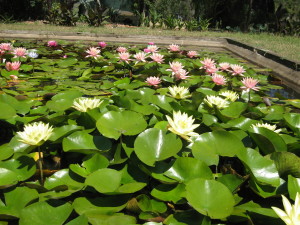 Water lilies are the most popular water plants for decorative ponds. There is an exciting range of sizes and colours for many depths and growing conditions. Pygmy species can be grown in as little as 250 mm of water while large ones thrive at depths of half a metre or more. Lilies like lots of sunshine and should have at least 4 hours of direct sunlight a day. Colours range from white, through yellows and pinks to reds and deep purples.
Water lilies are the most popular water plants for decorative ponds. There is an exciting range of sizes and colours for many depths and growing conditions. Pygmy species can be grown in as little as 250 mm of water while large ones thrive at depths of half a metre or more. Lilies like lots of sunshine and should have at least 4 hours of direct sunlight a day. Colours range from white, through yellows and pinks to reds and deep purples.
Water lilies are divided into temperate and Sub tropical types-
Temperate lilies – grow in the temperate parts of Australia and can withstand the water freezing over in winter when they are dormant. They carry their flowers close to the water surface. The pygmy water lilies are in this group. Temperate lilies flower early in the season as days lengthen, increased sunny hours increases flowering.
Sub Tropical water lilies – can be grown in Australia where there are warm to hot summers. In temperate areas of Australia these lilies will die back to bulbs during the winter but can be grown in coastal areas as far south as Melbourne. The flowering of sub tropical lilies is controlled by water temperature. Therefore, they will begin to flower later in the season and will continue to flower while ever the water temperatures are moderate. They carry their flowers high out of the water.
Cultivating Lilies and Other Water Plants –
Lilies should be grown in still or slowly moving water but this can be anything from tiny tubs to huge lagoons. Normally, in decorative growing of water lilies they are grown as potted plants so they can be moved, fed, divided, and repotted just like any other plant; they just grow in the water.
Potting and Repotting Lilies and Water Plants –
Water lilies should be repotted, or fed at the beginning of the growing season each year for best growth and flowering. This is best done in spring and summer, Water lilies are heavy feeders and need enough fertilizer to last the whole growing season. The directions below give a standard potting method for water lilies and plants.
1. Remove most of the dirt around the roots of the plant carefully and divide if necessary with a sharp knife.
2. Line the pot with newspaper or other material. This stops the soil seeping out of the bottom of the pot into the water.(minimum20cm pot for lilies).
3. Fill the pot approximately two thirds with a mix of some heavy loam* and add about one tablespoon of 50/50 blood & bone and pelletized poultry manure. ( or use our purpose made waterplant food).
4. Place the plant in the pot on top with roots into fed soil.
5. Top with unfed soil with growing tips above finished soil level.
6.If the lilies need feeding (this is apparent when mature leaves are small and the plant flowers less in summer ) but do not need repotting, place about a full teaspoon of fertilizer mix in a tissue and insert this in the pot next to the roots.
Other emergent and even bog plants are potted in the same way. Just water depth varies.
* Heavy loam or clay loam describes a natural soil which has some clay content, this is NOT sand and NOT potting mix or a soil enriched with compost or organic matter. It is the most suitable thing to plant water lilies in as it stabilizes the nutrients in the pot and minimizes problems of other media.
Fish-
Fish are an essential part of your pond or dam, needed to keep the water free from insects that eat plants (cadis fly larvae) or those that attack humans (mosquito larvae). However, if you want your plants to do well, avoid Koi Carp as these fish will dig up your plants and dirty the water.
Happy Gardening!
And remember, you can always ring for advice on (02) 49 380 230 or Contact Us.

